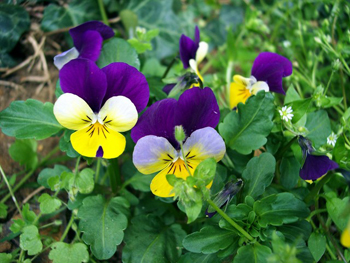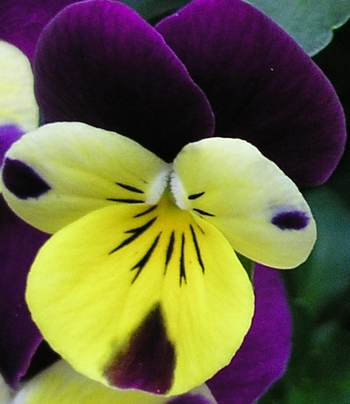Contents:
Common Names | Parts Usually Used | Plant(s) & Culture | Where Found | Medicinal Properties | Biochemical Information
Legends, Myths and Stories | Uses | Formulas or Dosages | Warning | Bibliography
Scientific Names

- Viola tricolor L.
- Violaceae
- Violet family
Common Names
- Butterfly flower
- Cull me to you
- Garden violet
- Heart’s-Ease
- Johnny jumper
- Johnny-jump-up
- Love-in-idleness
- Pancies
- Stepmother
- Three faces in a hood
Parts Usually Used
Leaves
Back to Top

Description of Plant(s) and Culture
The pansy is an annual plant; the soft, angular, hollow stem, 4-12 inches high, bears alternate, ovate to lanceolate, toothed leaves on the lower part of the plant. Stipules are large, leaflike, and strongly divided. The solitary, axillary flowers may be yellow, blue, violet, or two-colored, the flowering time is from March to October.
Back to Top
Where Found
Widely cultivated as a garden ornamental but is also found wild in fields and meadows, heaths, moors, sunny banks, and along the edges of forests in North America, northern Asia, and Europe.
Back to Top
Medicinal Properties
Anodyne, demulcent, diaphoretic, diuretic, expectorant, laxative, vulnerary
Back to Top
Biochemical Information
Mucilage, salicylic acid, saponins, a flavonic glycoside called violaquercetin
Back to Top
Legends, Myths and Stories
Although pansy is known as heart’s ease, there is another herb known as heart’s ease or lady’s thumb (Polygonum persicaria L.). Lady’s thumb is of the buckwheat family and has no similarity whatsoever to the pansy.
Legend has it that the flowers, originally white, were turned purple by one of Cupid’s arrows, thus the basal leaves are heart-shaped.
Used medicinally since ancient times; once used in love potions, hence the name of heart’s ease.
Back to Top
Uses
An infusion of Pansy is useful for skin eruptions, diarrhea, and urinary problems, fevers, mild sedative, blood purifier, asthma, heart palpitations, jaundice, gout, rheumatic problems, arteriosclerosis, high blood pressure, dry throat, pleurisy, itch, cough, blemished skin, psoriasis, acne, sebhorrheic skin (scaly) diseases, cradle cap in infants and children, convulsions, epilepsy, sores, ulcers, varicose veins, prevents colds, bedwetting, retinal hemorrhages, tendency to bruise easily, hives, diaper rash, nervous complaints, hysteria, chest congestion, lung inflammations, and cramps in children. The dried and powdered plant can be applied to wounds or made into a salve with honey for external use.
Back to Top
Formulas or Dosages
Harvest while flowering.
Infusion: steep 1 to 2 tsp. plant in 1/2 cup boiling water. Take 1 cup a day, a mouthful at a time.
Cold extract: soak 2 to 4 tsp. plant in 1 cup cold water for 8 hours. Take 1 cup a day, a mouthful at a time.
Back to Top
Warning
Contains saponins; may be toxic in larger doses. May induce nausea and vomiting.
Excessive doses or prolonged, continuous use can lead to skin problems.
Back to Top
Bibliography
![]() American Folk Medicine
American Folk Medicine, by Clarence Meyer, Meyerbooks, publisher, PO Box 427, Glenwood, Illinois 60425, 1973
![]() The Complete Medicinal Herbal
The Complete Medicinal Herbal, by Penelope Ody, Dorling Kindersley, Inc, 232 Madison Avenue, New York, NY 10016, First American Edition, copyright 1993
![]() Culpeper’s Complete Herbal & English Physician: Updated With 117 Modern Herbs
Culpeper’s Complete Herbal & English Physician: Updated With 117 Modern Herbs, by Nicholas Culpeper, Meyerbooks, publisher, PO Box 427, Glenwood, Illinois 60425, 1990, (reprint of 1814)
![]() Eastern/Central Medicinal Plants
Eastern/Central Medicinal Plants, by Steven Foster and James A. Duke., Houghton Mifflin Company, 215 Park Avenue South, New York, NY 10000
Herbal Gardening, compiled by The Robison York State Herb Garden, Cornell Plantations, Matthaei Botanical Gardens of the University of Michigan, University of California Botanical Garden, Berkeley., Pantheon Books, Knopf Publishing Group, New York, 1994, first edition
 The Healing Plants
The Healing Plants, by Mannfried Pahlow, Barron’s Educational Series, Inc. 250 Wireless Blvd., Hauppauge, NY 11788, 1992
![]() The Herb Book
The Herb Book, by John Lust, Bantam Books, 666 Fifth Avenue, New York, NY. copyright 1974.
 The Magic of Herbs
The Magic of Herbs, by David Conway, published by Jonathan Cape, Thirty Bedford Square, London, England. (Out of print)
![]() The Nature Doctor: A Manual of Traditional and Complementary Medicine
The Nature Doctor: A Manual of Traditional and Complementary Medicine, by Dr. H.C.A. Vogel; Keats Publishing, Inc., 27 Pine Street (Box 876) New Canaan, CT. 06840-0876. Copyright Verlag A. Vogel, Teufen (AR) Switzerland 1952, 1991
![]() Planetary Herbology
Planetary Herbology, by Michael Tierra, C.A., N.D., O.M.D., Lotus Press, PO Box 325, Twin Lakes. WI 53181., Copyright 1988, published 1992
![]() Webster’s New World Dictionary
Webster’s New World Dictionary, Third College Edition, Victoria Neufeldt, Editor in Chief, New World Dictionaries: A Division of Simon & Schuster, Inc., 15 Columbus Circle, New York, NY 10023
 The Rodale Herb Book: How to Use, Grow, and Buy Nature’s Miracle Plants (An Organic gardening and farming book)
The Rodale Herb Book: How to Use, Grow, and Buy Nature’s Miracle Plants (An Organic gardening and farming book), edited by William H. Hylton, Rodale Press, Inc. Emmaus, PA, 18049., 1974
